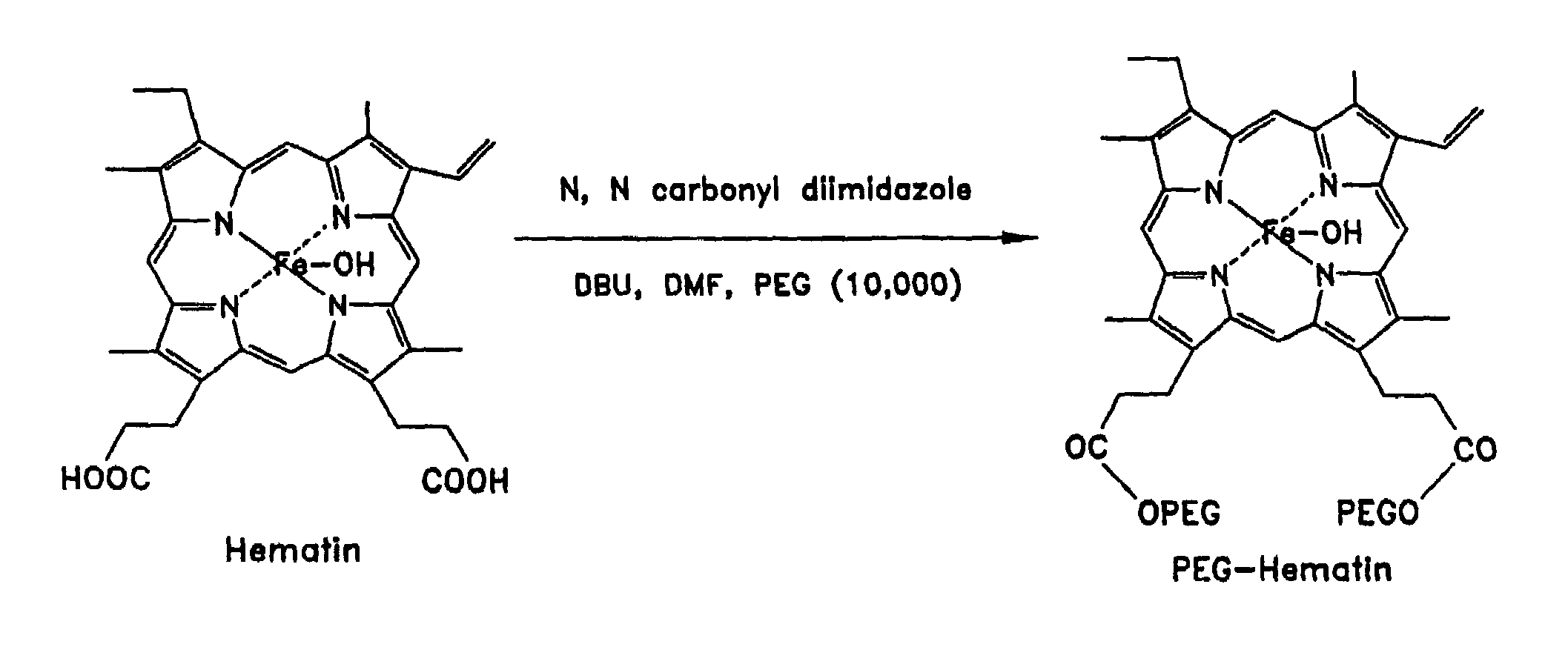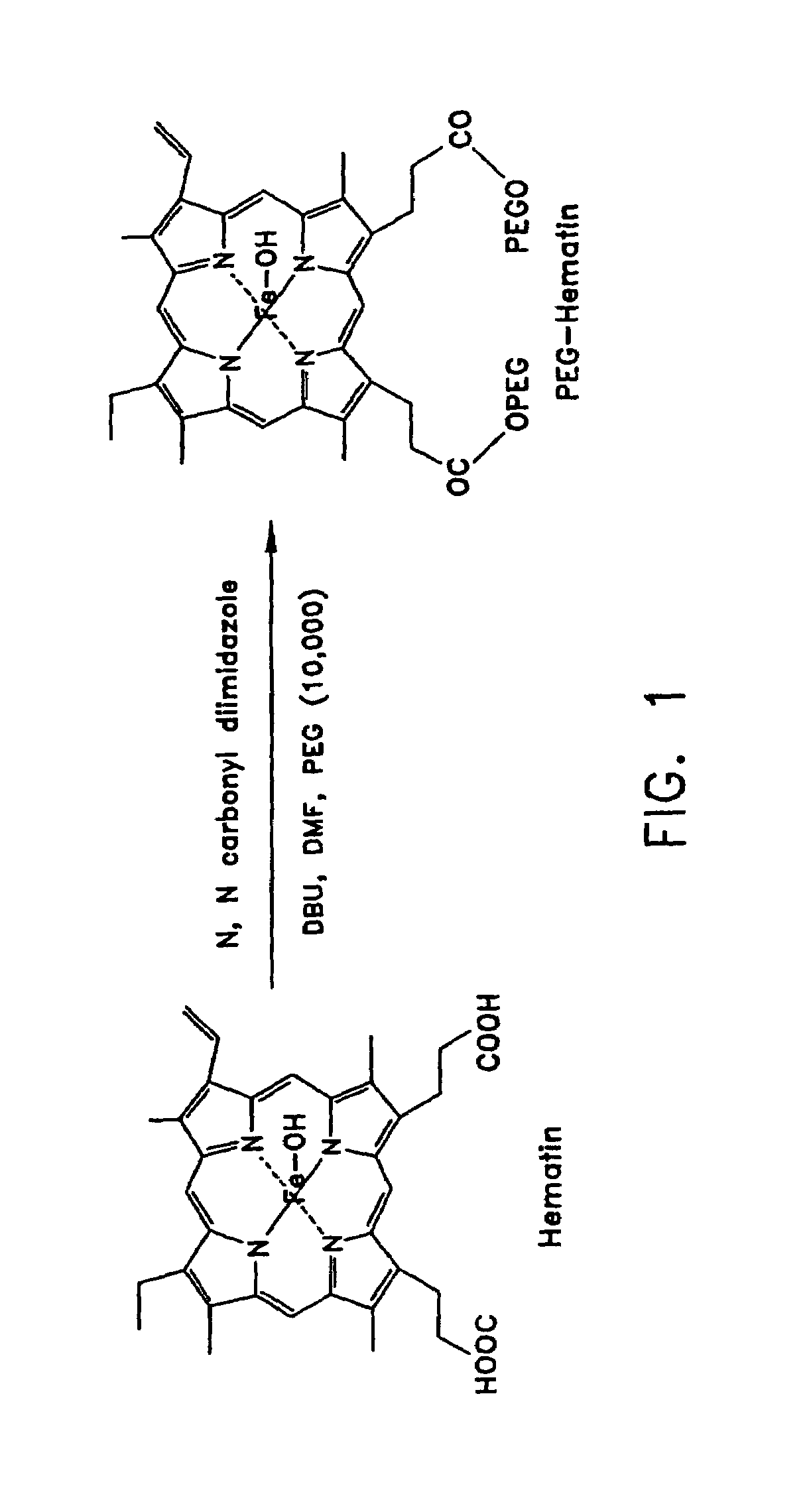Methods for polymerization of electronic and photonic polymers
a technology of electronic and photonic polymers and polyaromatic polymers, applied in the field of polyaromatic polymers, can solve the problems of affecting the synthesis of polyphenols, presenting significant toxicological and environmental hazards, and a significant use of formaldehyde in polyphenol synthesis, so as to reduce the cost of catalysts, reduce the amount of branching during polymerization, and the effect of exceptional stability
- Summary
- Abstract
- Description
- Claims
- Application Information
AI Technical Summary
Benefits of technology
Problems solved by technology
Method used
Image
Examples
example 1
Synthesis of PEG-Hematin Complex
[0087]The PEG-hematin complex was obtained through the coupling of PEG chains to a hematin molecule through ester linkages as shown in FIG. 1. The PEG-hematin complex was prepared by the addition of a mole equivalent of PEG (19 mg) to hematin (200 mg) in the presence of activators N,N′-carbonyldiimidazole (0.05 g) and 1,8-diazabicyclo[5.4.0]undec-7-ene (DBU) (0.047 g) in DMF. The mixture was allowed to stir for 48 hours then was quenched by the addition of a large volume of deionized water. The unreacted reagents were removed by extraction with ethyl acetate. The water layer was subsequently lyophilized to yield PEG-hematin as a reddish-brown solid.
[0088]The complex was characterized using NMR and FTIR spectroscopy. The average extent of modification of the acidic groups of hematin was determined using UV-vis spectroscopy. The UV-vis spectra of the PEG-hematin exhibited a decrease in the Soret band (420 nm), a porphyrin centered π-π* transition, in co...
example 2
Synthesis of Polyanine (Pani)
[0092]The polymerization of aniline was carried out in 0.1 M sodium phosphate buffer (10 mL) maintained at pH 1. To this buffer solution the aniline monomer was added. The catalyst, PEG-hematin (60 μg), was added only just prior to the addition of hydrogen peroxide. The polymerizatrion was initiated by the incremental addition of a stoichiometric amount of hydrogen peroxide, with respect to aniline. 0.3% H2O2 (w / v) was used with constant stirring and the progress of the reaction was monitored spectroscopically (FIG. 5). Typically, all reaction systems were left stirred until completion of polymerization followed by precipitation of the pani. The pani synthesized was filtered off and thoroughly washed with acetone a few times followed by drying in a vacuum oven. The conductivity of the pani pellet was found to be of the order of 0.2 S / cm.
[0093]This reaction thus proved the versatility and ability of the PEG-Hematin for the synthesis of stable conducting p...
example 3
Synthesis of Sodium Poly (sodium-4-styrenesulfonate)-Polyaniline Complex
[0094]The polymerization of aniline was carried out in 0.1 M sodium phosphate buffer over a range of pH conditions from pH 1–4. A 17 mM solution of SPS template in phosphate buffer (100 mM) was prepared to which the aniline monomer was added in a 1:1 molar ratio of aniline to sodium styrene sulfonate monomer. The catalyst, PEG-hematin (5 mg), was added just prior to the addition of hydrogen peroxide. The polymerization was initiated by the incremental addition of a stoichiometric amount of hydrogen peroxide (relative to aniline). In all cases, 0.3% H2O2 (w / v) was used with constant stirring, and the progress of the reaction was monitored spectroscopically. On completion of polymerization, the solution was transferred to individual regenerated natural cellulose membrane bags (molecular weight cut-off 10,000 D) and were dialyzed against 5000 mL of acidified deionized water maintained at pH 4.0 to remove unreacted ...
PUM
| Property | Measurement | Unit |
|---|---|---|
| pH | aaaaa | aaaaa |
| pH | aaaaa | aaaaa |
| pH | aaaaa | aaaaa |
Abstract
Description
Claims
Application Information
 Login to View More
Login to View More - R&D
- Intellectual Property
- Life Sciences
- Materials
- Tech Scout
- Unparalleled Data Quality
- Higher Quality Content
- 60% Fewer Hallucinations
Browse by: Latest US Patents, China's latest patents, Technical Efficacy Thesaurus, Application Domain, Technology Topic, Popular Technical Reports.
© 2025 PatSnap. All rights reserved.Legal|Privacy policy|Modern Slavery Act Transparency Statement|Sitemap|About US| Contact US: help@patsnap.com



